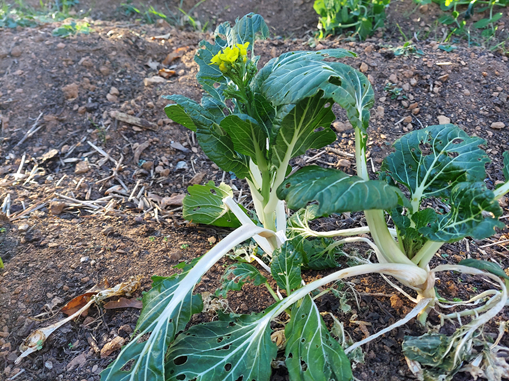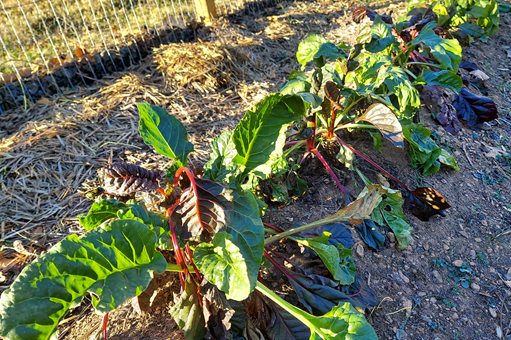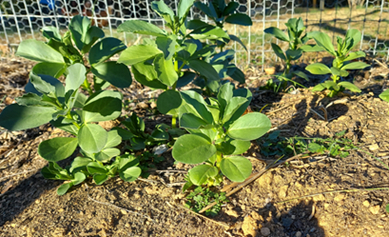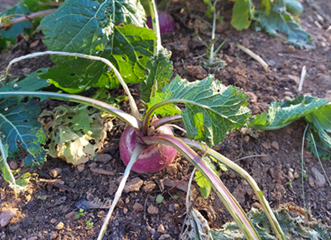
Home >> Newsletters > GreenFriends Newsletters > Q1 2022 Newsletter
| Home | Source Reduction | Friends of Green Friends | Newsletters |
| Gardening | Resources | What You Can Do | Embracing The Trees |
|
Winter Gardening - Extend the Season End of the Summer into Fall/Winter |
||
|
||
|
So, summer has come to a close, and one would normally think: ah, all of the harvest is in, and I can now relax. But no, in reality, there is no relaxing if one wants to enjoy produce from a winter garden. Planting cold-weather crops can provide an additional source of organic produce, and these crops would not have fared so well during the heat of the summer. It is also a time to store your root crops such as beets, sweet potatoes, yams, onions, garlic, carrots, and potatoes in a root cellar, or the coolest, darkest place in the house, such as a mudroom. You might also wish to pickle, can, and freeze some of your crops for later use, such as canned tomatoes, pickled beets, pickled rutabaga, pickled turnips, etc., if you haven’t done so already.
|
||
Timing and choices for Cold-Weather Crops In August-September (even early October here in North Carolina) one can plant a host of veggies that prefer the colder temperatures: arugula, beets, broccoli, Brussels sprouts, cabbages, carrots, cauliflower, collard greens, fava beans, kale, kohlrabi, lettuce, parsnips, radishes, rutabaga, salad greens, spinach, and turnips are among the most common. These can be grown even in northern parts of the country where they are aided by row covers which consist of hoops covered with a specific type of cloth that allow sun and rain to penetrate but protect plants from severe cold, wind, snow and ice. Row-covers are also useful during the spring-fall months. They deter insects from eating your plants and produce, and for plants that don’t tolerate harsh sun, will protect them from intense heat and sunlight. It is generally a good idea to keep a garden journal (believe me when I tell you that your memory will fail you once spring rolls around!) so that you know what you planted in each segment of the garden so that you can rotate your crops. This is done essentially to avoid depleting the soil. Each plant uses different combinations of minerals from the soil. Some plants - like fava beans - are "cover crops", which help to replenish certain minerals in the soil. They are a useful multi-purpose crop used to create “green manure” by feeding the soil with green matter before maturity, as opposed to compost, which is decomposed matter. Fava beans may be allowed to mature in order to harvest leaves, flowers and pods for consumption throughout the winter and spring. They are a particularly tasty and hearty bean with high protein and a wonderful alternative to meat. There are many other cover crops that one can grow that provide a world of benefits to the garden. |
||
|
|
Cover Crops Cover crops may be planted in summer or fall and then left to overwinter. Cover crops improve soil organic matter and fertility, suppress cool-season weeds, prevent soil erosion, and create a better seedbed for spring planting. There are two types: Winter-killed cover crops (which are killed by cold, but have sufficient biomass to protect the soil) such as oats, field-pea, oilseed radish and rapeseed. The second type of cover crop is winter-hardy, which as you may have already surmised, survive the winter and resume growth in the spring. Some of these are winter-rye, winter wheat, hairy vetch, winter peas and crimson clover. Garden Journal You can also make notations in your garden journal indicating the last frost date experienced in the spring and the first fall frost date as a guideline for planting and harvesting. Note what you had success with and what you didn’t. You may want to make other notes for yourself so that you can have greater success in following years, although this isn’t a guarantee by any means. Of course, one must tidy up the garden a bit before planting; which means removing the debris from previous summer plantings, pulling weeds, and reshaping beds that may have been disturbed by harvesting and weeding. Plan to plant your seeds according to the directions on the packages, however, you may insert seeds just a tad deeper to protect them from cooler temperatures, and then water as needed depending upon your climate. It is also recommended that you source your seeds if possible from a regionally local source so that you are planting seeds that will be most likely to succeed in your area with your specific climate and soil conditions. It is likely too late now to plant a winter garden for most areas of the country, however, you can plan to do so next year. And, remember to have fun — researching what to grow, how to grow it and then getting out into the soil and getting your hands dirty by preparing beds and then planting seeds or seedlings. |
|
Gardening is fun, a true adventure, a gift from Mother Nature (Bhu Devi), for us to explore, engage in and enjoy. (I call these the three e’s!) It is also an opportunity for families and friends to plant, water, weed and harvest together. It’s a wonderful way to teach children about Nature, and where their food comes from which helps to endow in them a sense of wonder, appreciation and respect for Nature. An added bonus is that you are teaching life-long skills that will help them to feed themselves at least to some extent in the future if they so desire . "Life is like a garden. Quite naturally, leaves wither and flowers fade. Only if we clear the decay of the past then and there can we really enjoy the beauty of the new leaves and flowers. Likewise, we must clear the murkiness of the past bad experiences from our minds. Life is remembrance in forgetfulness. Forgive what ought to be forgiven; forget what ought to be forgotten. Let us embrace life with renewed vigor. We should be able to face every moment of life with renewed expectation, like a freshly blossomed flower." Here is what Mother Nature bestowed upon us at the end of our summer harvest (end of November!). We feel so grateful to have so many veggies - such as eggplant (Japanese and Italian), tomatoes (cherry and heirloom), watermelon, Swiss chard (rainbow), red, orange and green peppers, and some produce from our cold-weather crops such as radishes (multiple variety) and bok choy. Satyavrtan and Raja Sri Rutenbeck - North Carolina |
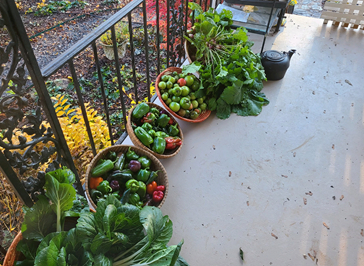 Late fall harvest |
Read about Learning to Darn in the Q1 2022 newsletter >>
| Home | Source Reduction | Friends of Green Friends | Newsletters | Resources | What You Can Do | Contact Us |
For more information, e-mail info@greenfriendsna.org |
||||||
